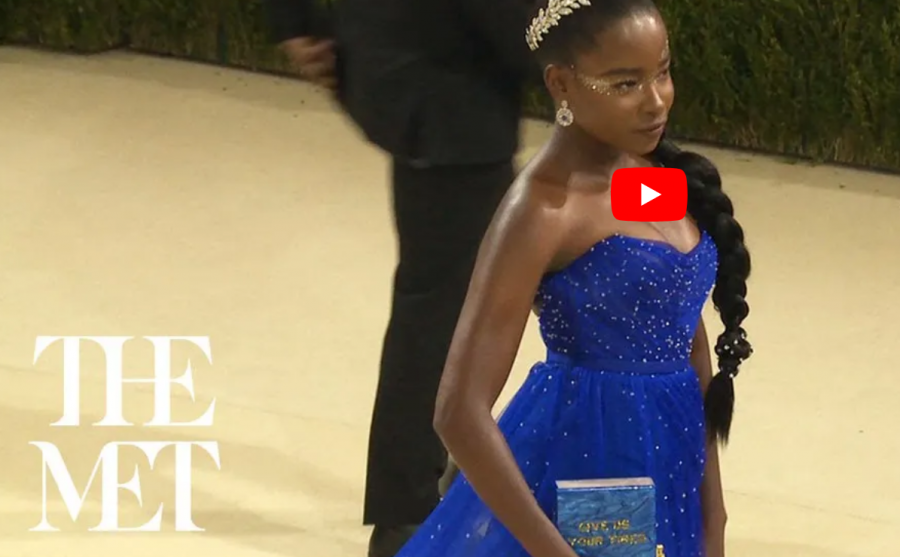Gen Z Stars Dominate Met Gala
September 24, 2021
Following the Met Gala’s pandemic hiatus, fashion’s biggest night made its return on September 13th. Brimming with extravagant fashion statements made by esteemed celebrities, the night remained true to form. But the 2021 spectacle featured a new generation of stars, who weren’t afraid to steal the spotlight on Upper Fifth Avenue.
A first in Met Gala history, all four of the co-hosts—actor Timothée Chalamet, artist Billie Eilish, poet Amanda Gorman, and tennis superstar Naomi Osaka—were Gen Z. Each co-host delivered distinguished fashion statements on the carpet, of course, honoring this year’s theme: American independence.
Making a statement with his simple yet elegant look, Chalamet walked the carpet in an entirely white piece comprised of a tuxedo jacket, sweatpants, and Converse sneakers. In an event so notorious for its dynamism, his look eased the room’s energy. Next to Chalamet was Eilish, who entered the carpet with elegance in her show-stopping peach dress. Following Eilish, Gorman graced the carpet in her stellar royal blue dress, and Osaka in her brilliant asymmetrical ensemble.
These co-hosts were joined by a large crowd of Gen Z-ers including Olivia Rodrigo, 18, who was one of the youngest on the red carpet; Emma Chamberlain, 20, who caught the eyes of many with her glamorous Louis Vitton look; Lil Nas X, 22, who rocked the carpet with not one or two, but three gold Versace outfits; Addison Rae, 20, who stunned the carpet in her daring red look; and Hunter Schafer, 22, who dazzled in her two-piece magnetic set. While Gen Z reigned over the show, what went on behind the scenes?
Considering the Met Gala has a long-lived reputation as one of the most upscale, exclusive events in the celebrity world, the presence of social media influencers next to A-list Hollywood stars caused the event to receive some backlash. Social media debates transpired when influencers such as Emma Chamberlain, and TikTok sensations Addison Rae and Dixie D’Amelio appeared on a rumored seating chart. Many Met Gala followers worried that the younger generation would diminish the event’s prestige. “Why would they put the influencers next to the bigger celebrities,” one TikTok user asked. “Do they actually think that Dixie D’Amelio is on the same level as Billie Eilish?” Simultaneously, these reactions foster the assumption that Gen Z’s feats are restricted to the online world, causing their social media followers to undermine their successes. Comments such as “why is she there?,” “no reason for [you] to be at the met,” and “a wasted invitation” seen under Rae’s and D’Amelio’s Instagram posts may have undermined this generation’s status in the fashion world, the shift in who gets access to the exclusive red carpet did just the opposite of ruining the Met’s image—it increased its prominence in the social media world.
The novel range of celebrities who attended the gala brings about a more diverse sense of fashion to the event and highlights its evolution in America. While the fashion industry typically had an older audience due to the sole presence of A-list stars, the introduction of the younger generation not only altered the guest list but the event’s audience as well. “It was nice to see new faces at the Met,” Abby Kushman (’23) said. “[These] influencers brought a lot of attention in a good way because it drew a younger audience to the fashion world. While it was upsetting to see so many big stars not there, it didn’t destroy the prestige; [in fact,] it gave it a new perspective.” The guest list showcases a variety of young icons who are deemed influential enough to walk the carpet alongside fashion’s most esteemed celebrities, encouraging youth that they, too, are worthy of success.
Many viewers had two-sided opinions regarding Gen Z’s reign. “It makes it seem more like a popularity contest than celebrities showing off their outfits and creativity,” Alex Yanowitz (’23) said. Yet Yanowitz also believes that whether or not the event’s reputation is jeopardized by the younger generation’s presence depends on what they wear. When making their debuts, “the young stars don’t have to take away from everyone else while still making a statement,” Yanowitz said.
For instance, Emma Chamberlain, a first-time Met Gala attendee, captivated her extensive audience. “Emma Chamberlain’s style and fashion sense has influenced a lot of younger viewers,” Kushman said. “Her presence at the Met Gala showcased a different form of fashion. [Ultimately,] younger influencers brought younger audiences, which broadens the event’s horizons”
Each of the Met Gala’s co-hosts being under the age of 26 gives rise to the question of the Met Gala’s future. It’s exciting to see these young personalities progress into the world of fame accompanied by veteran celebrities. Moreover, this intertwining of various generations will expose the fashion world and fashion’s most renowned events to new faces on the carpet.

















































































































































